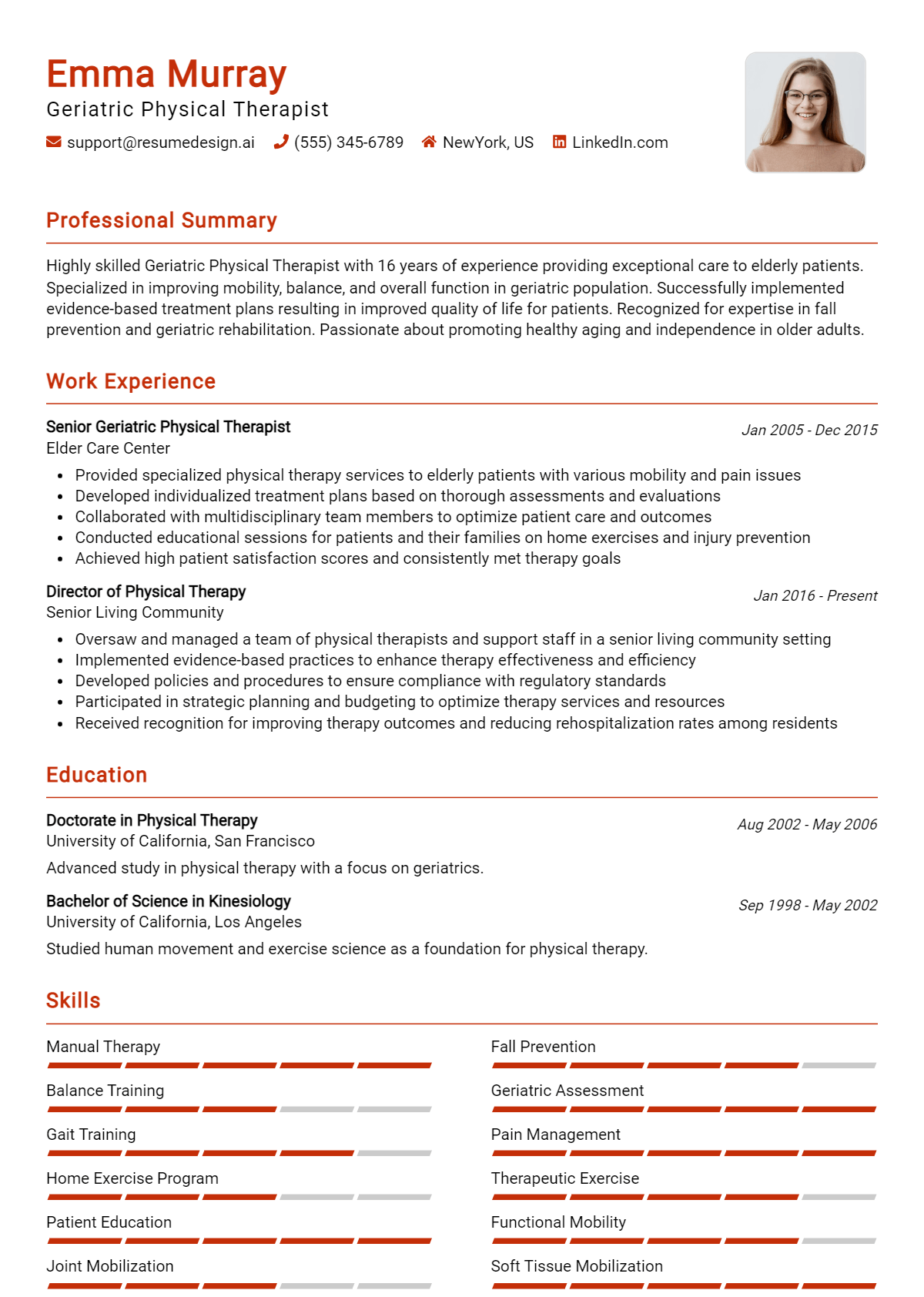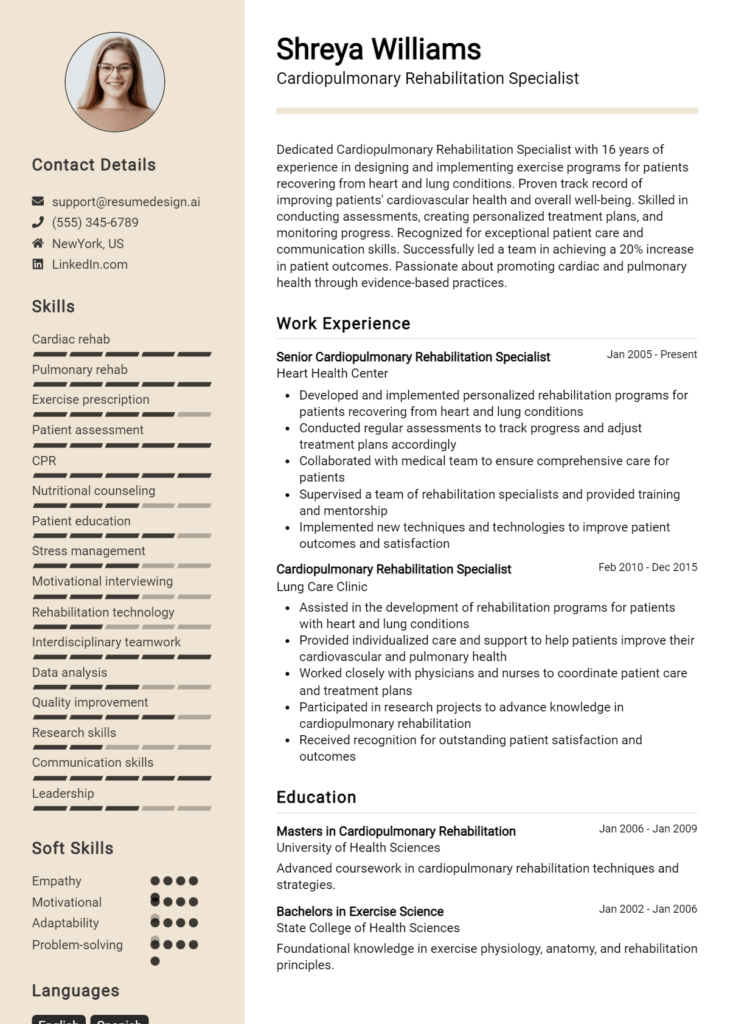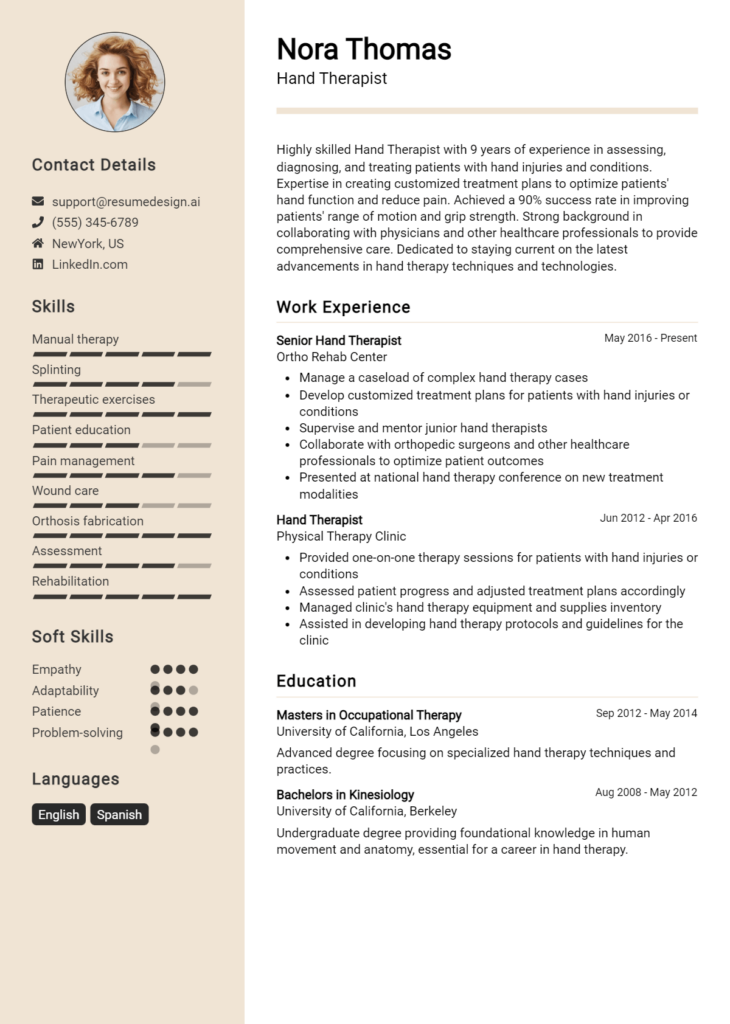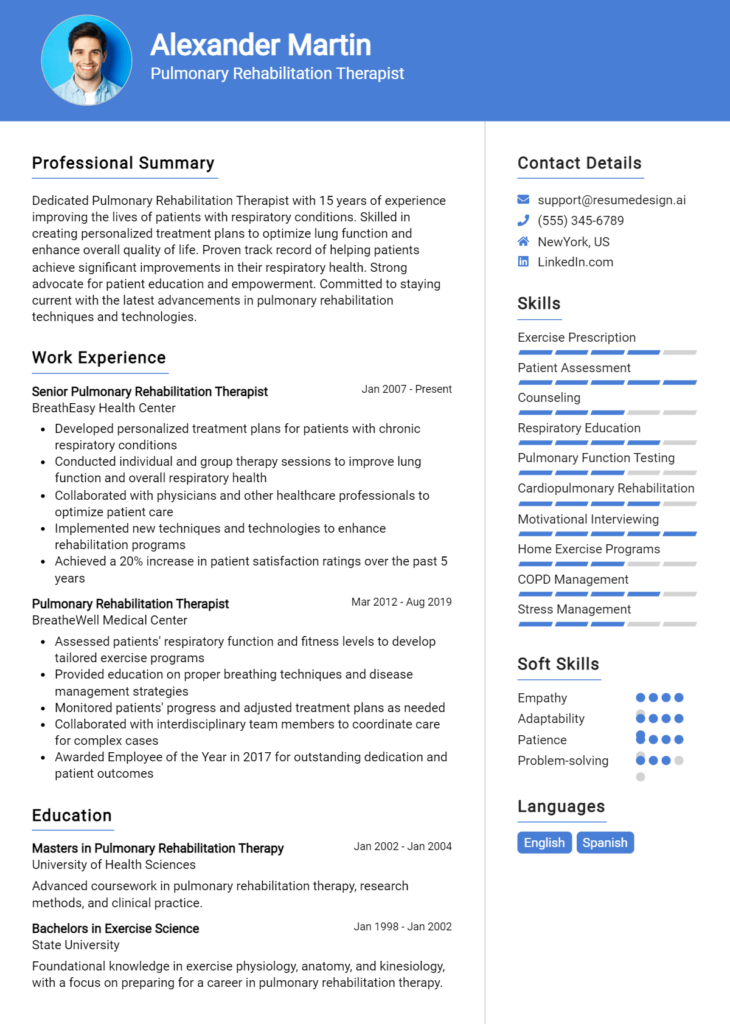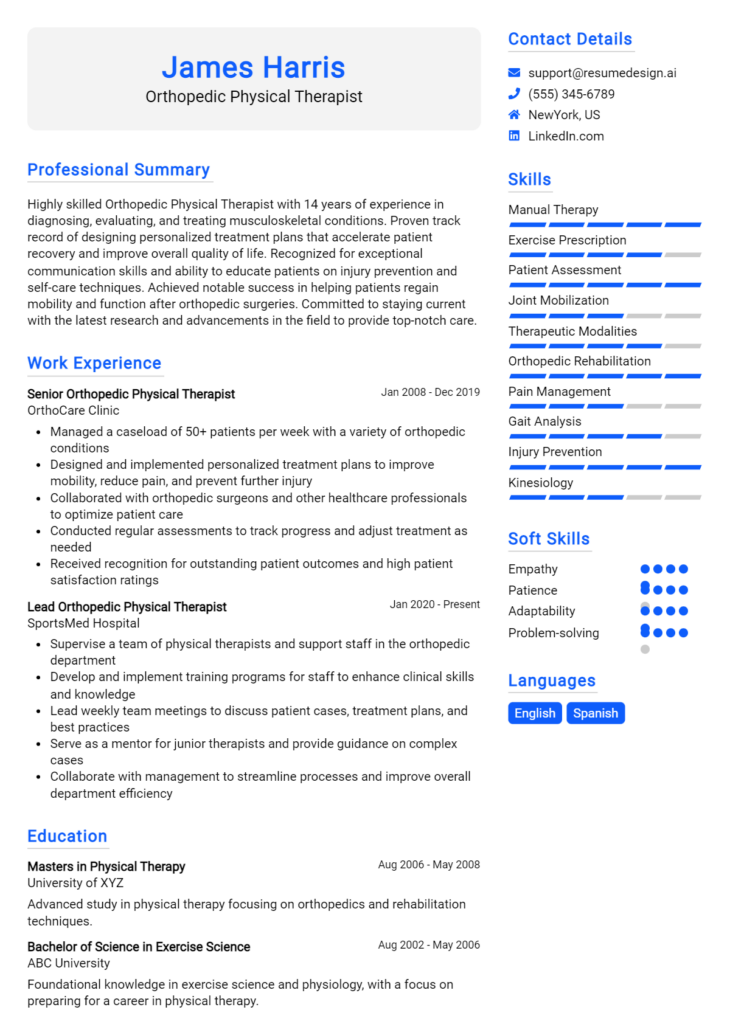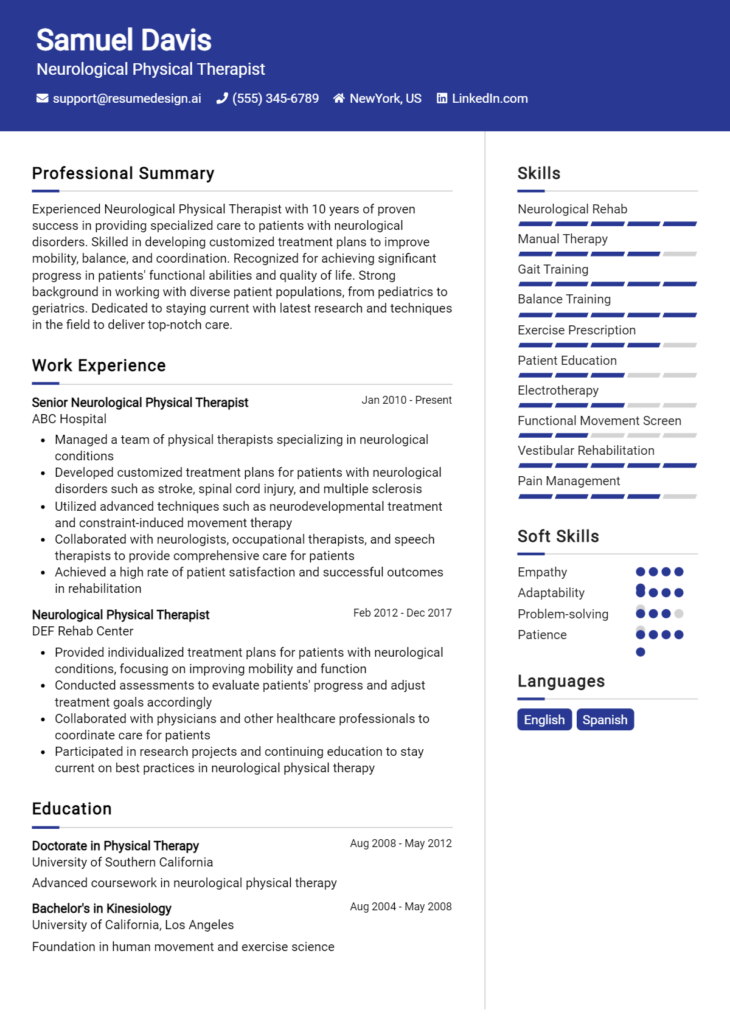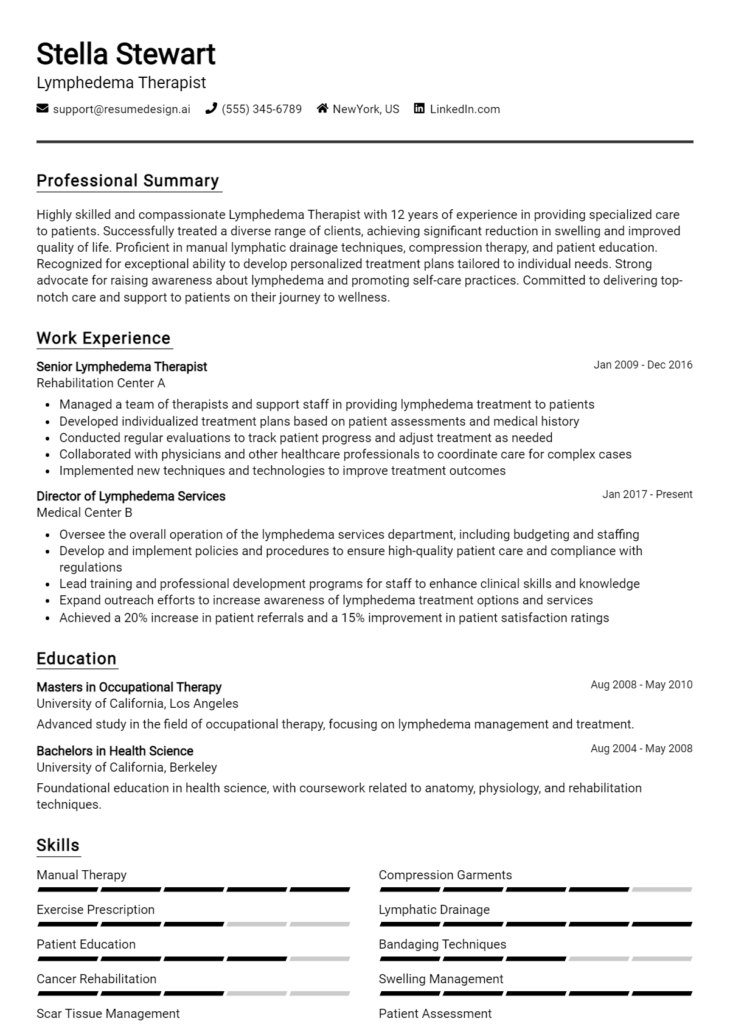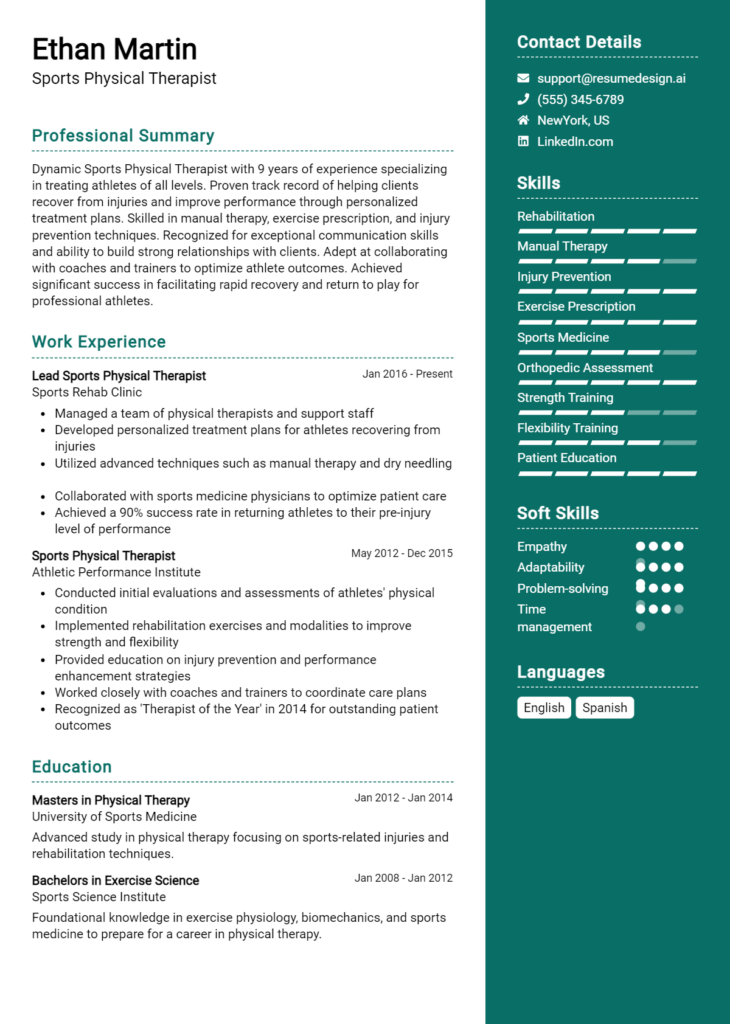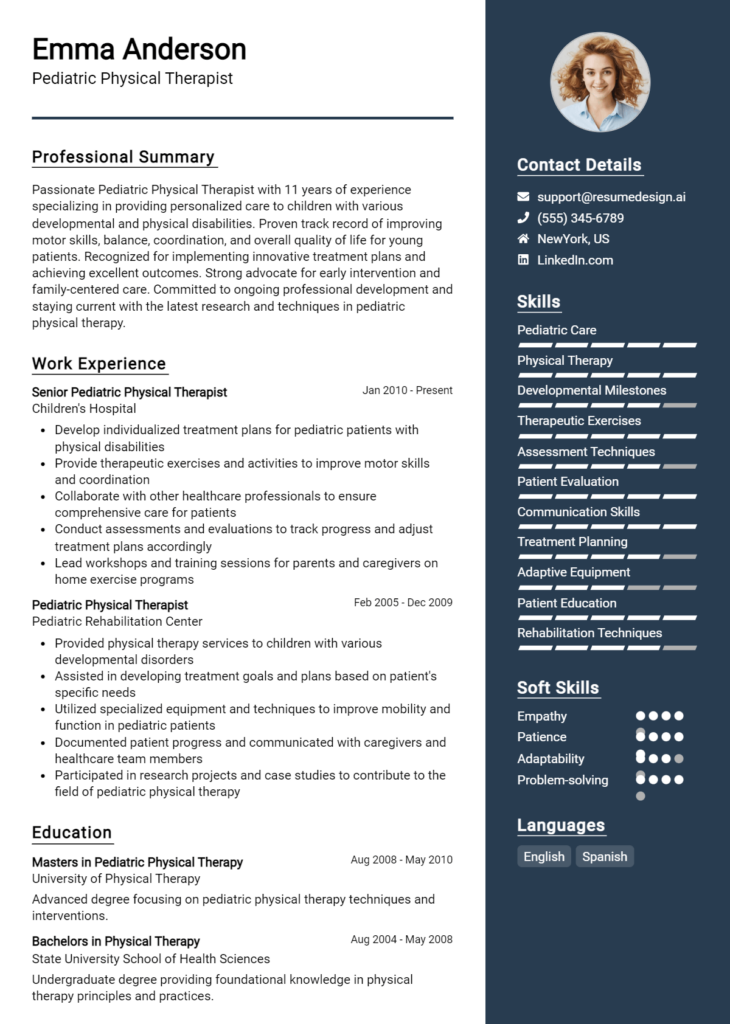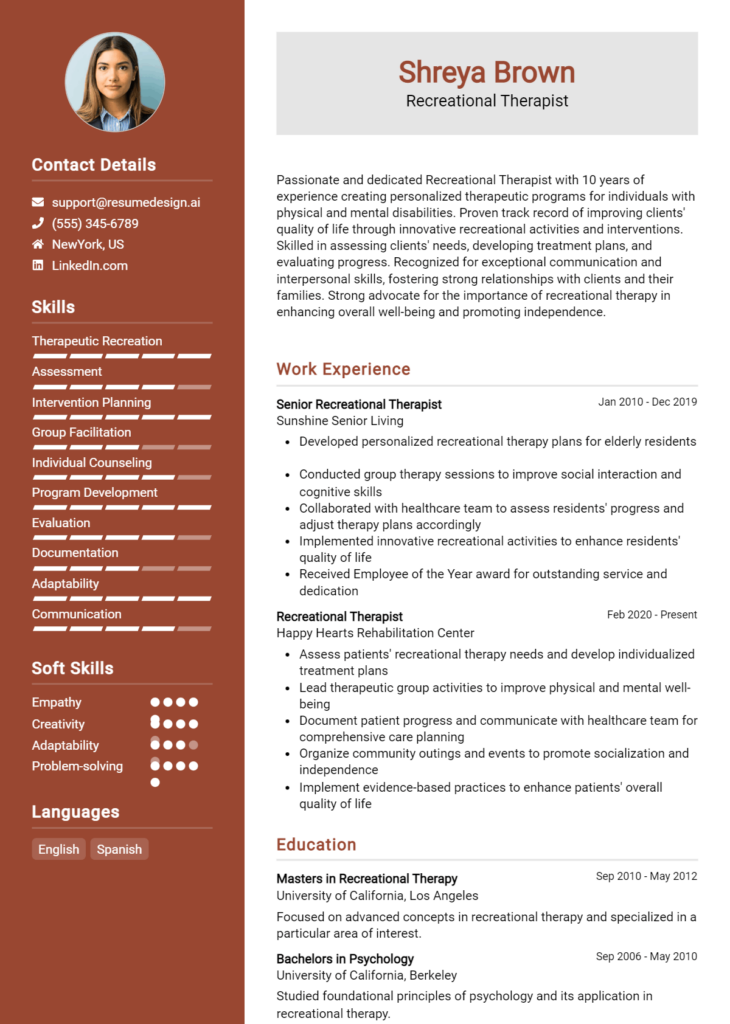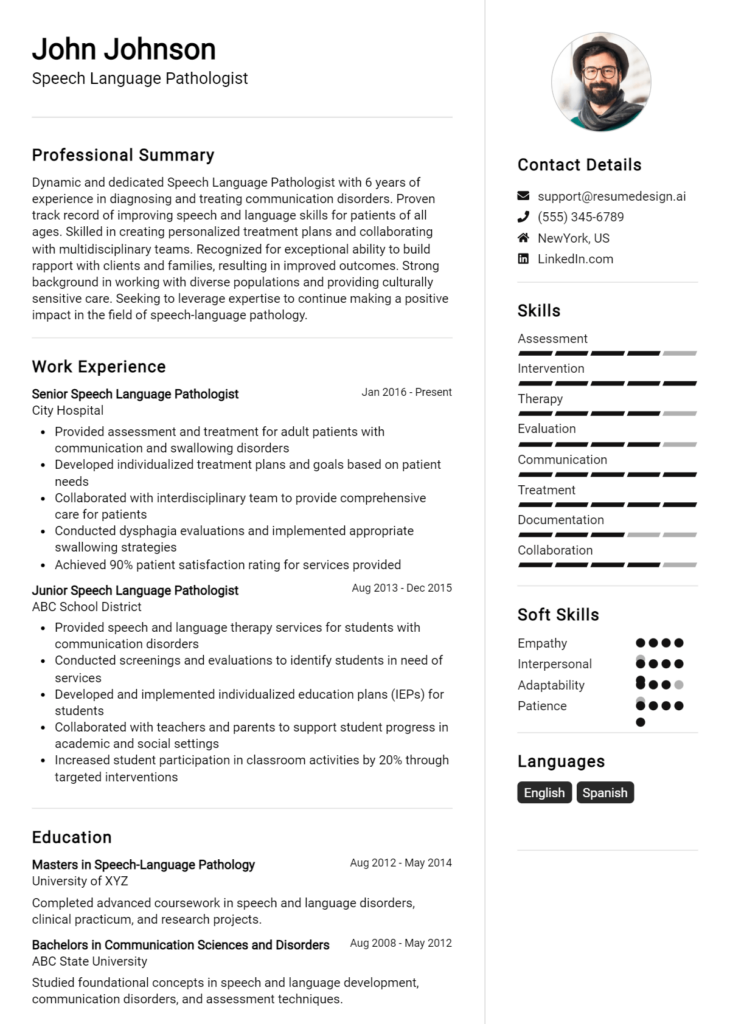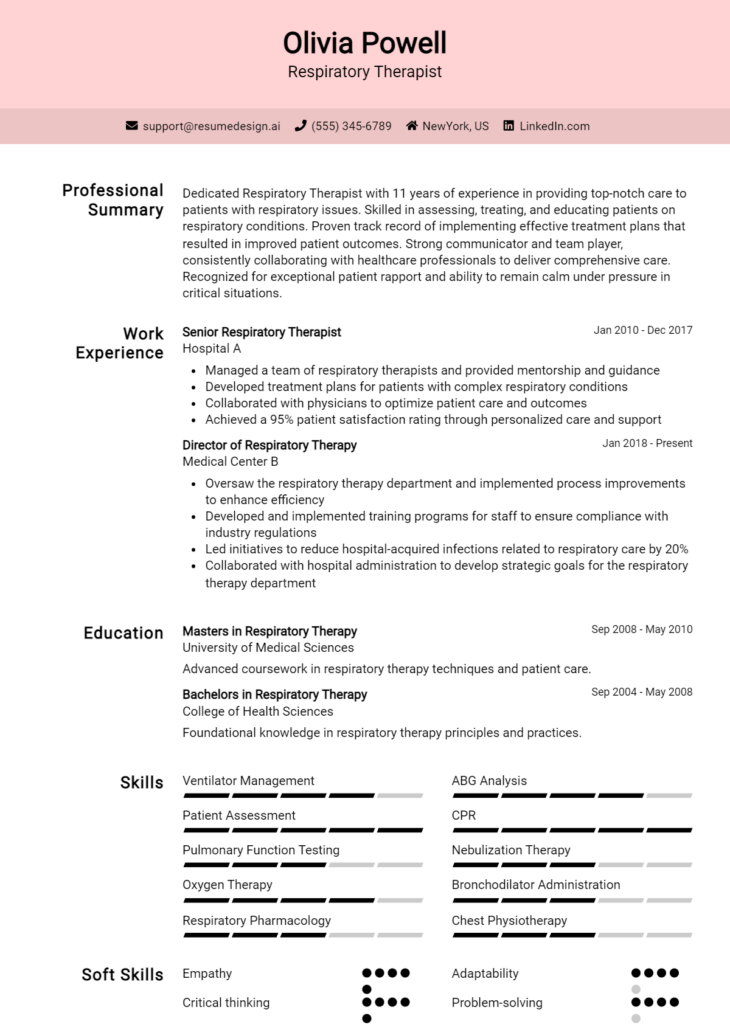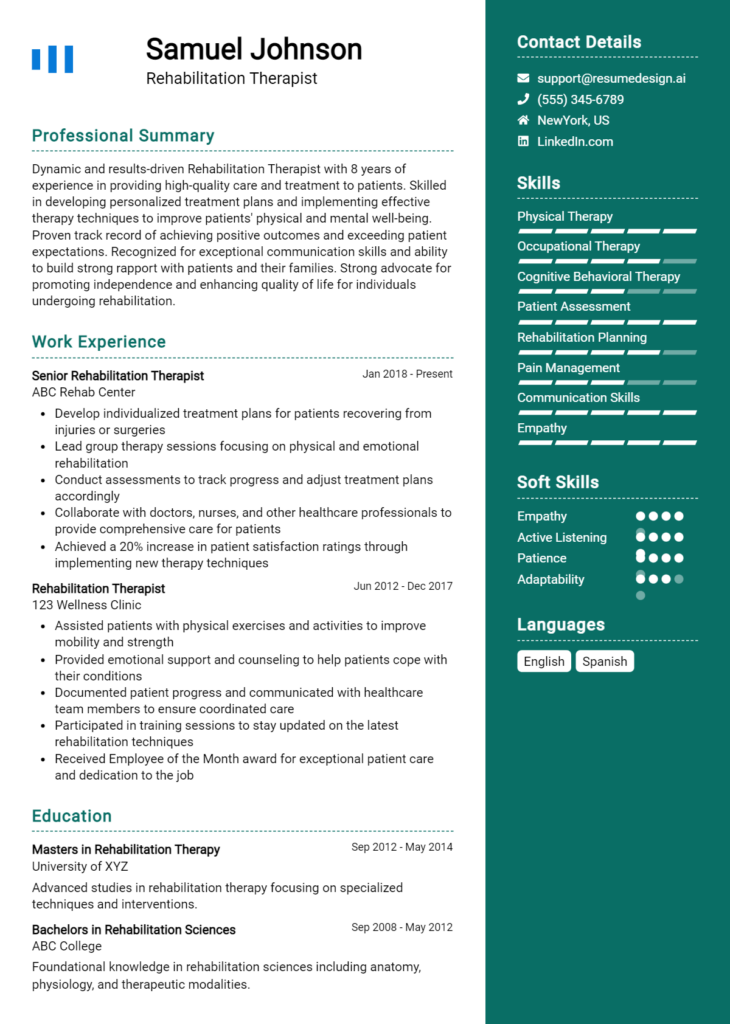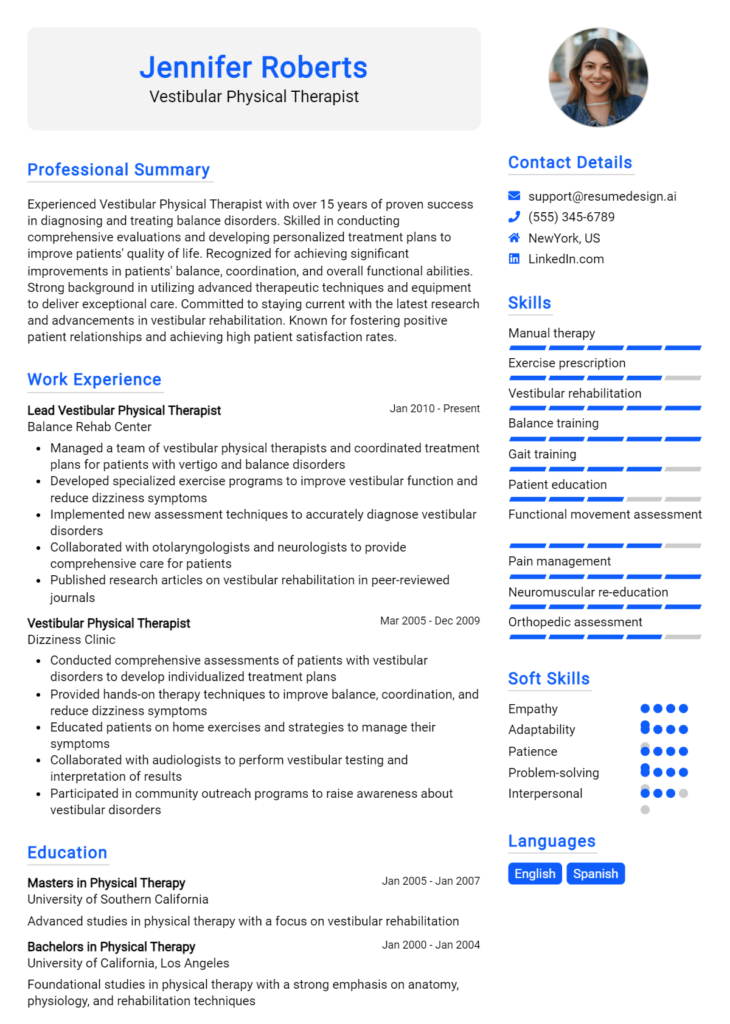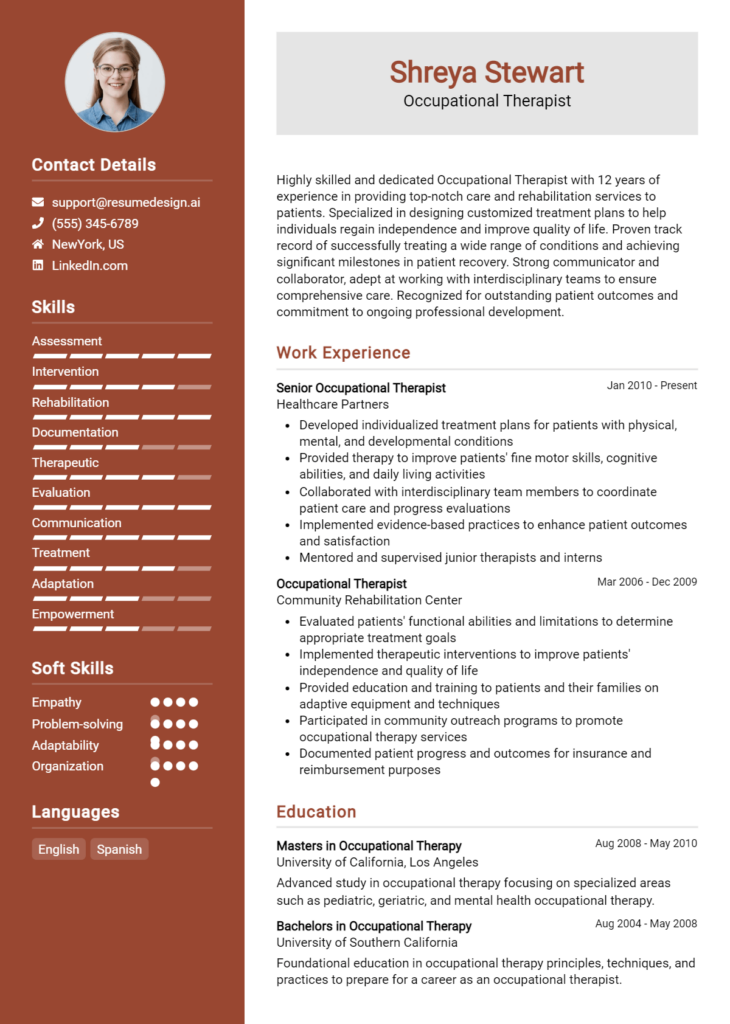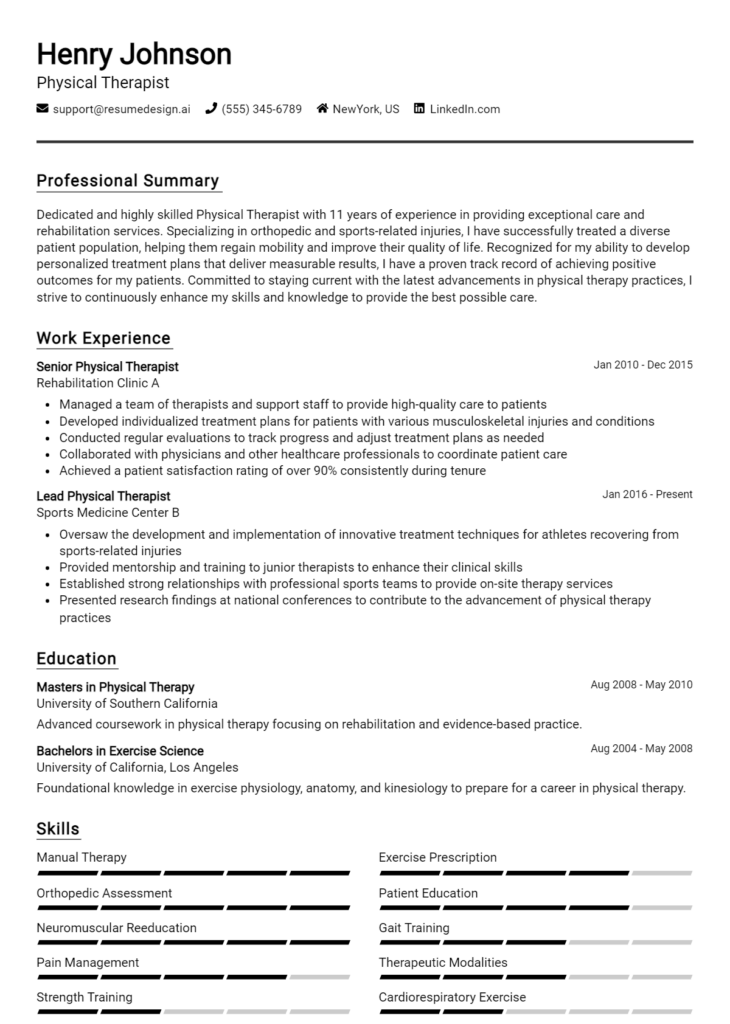Geriatric Physical Therapist Core Responsibilities
A Geriatric Physical Therapist is vital in enhancing the mobility and quality of life for elderly patients. Key responsibilities include assessing patient needs, developing individualized treatment plans, and collaborating with multidisciplinary teams to ensure comprehensive care. Essential skills encompass technical expertise in rehabilitation techniques, operational knowledge of healthcare protocols, and strong problem-solving abilities to address complex patient challenges. These competencies contribute significantly to organizational goals by enhancing patient outcomes. A well-structured resume can effectively highlight these qualifications to prospective employers.
Common Responsibilities Listed on Geriatric Physical Therapist Resume
- Conduct thorough assessments of elderly patients' physical capabilities.
- Develop and implement personalized rehabilitation programs.
- Monitor patient progress and adjust treatment plans as necessary.
- Educate patients and caregivers on exercise techniques and safety.
- Collaborate with physicians, nurses, and other healthcare professionals.
- Document patient treatments and progress in medical records.
- Utilize assistive devices and technology for enhanced mobility.
- Provide guidance on fall prevention and home safety modifications.
- Participate in patient and family education programs.
- Advocate for patient needs within the healthcare system.
- Stay updated on best practices and advancements in geriatric care.
- Engage in continuous professional development and training.
High-Level Resume Tips for Geriatric Physical Therapist Professionals
In the competitive landscape of healthcare, a well-crafted resume serves as a vital tool for Geriatric Physical Therapists seeking to make a lasting impression on potential employers. Your resume is often the first opportunity to showcase your expertise, skills, and achievements in a field that requires both specialized knowledge and compassionate care for the elderly. It is essential that this document not only highlights your qualifications but also reflects your understanding of the unique challenges and requirements of geriatric care. In this guide, we will provide practical and actionable resume tips specifically tailored for Geriatric Physical Therapist professionals, ensuring you stand out in the job market.
Top Resume Tips for Geriatric Physical Therapist Professionals
- Tailor your resume for each job application by carefully reviewing the job description and incorporating relevant keywords.
- Showcase your relevant experience in geriatrics, including internships, volunteer work, and previous positions, emphasizing your hands-on skills.
- Quantify your achievements with specific metrics, such as the number of patients treated or improvement rates in mobility or quality of life.
- Highlight industry-specific skills, such as knowledge of age-related conditions, therapeutic modalities, and adaptive equipment.
- Include certifications and continuing education related to geriatric care, demonstrating your commitment to professional development.
- Use a clean, professional format that is easy to read, ensuring that your most important information stands out.
- Incorporate a strong summary statement at the top of your resume that encapsulates your passion for geriatric care and your professional philosophy.
- Highlight your soft skills, such as empathy, communication, and teamwork, which are critical in working with elderly patients and their families.
- Include relevant volunteer work or community service that showcases your dedication to the geriatric population and your ability to work in diverse settings.
By implementing these resume tips, Geriatric Physical Therapists can significantly increase their chances of landing a job in a rewarding and impactful field. A polished resume that effectively communicates your qualifications, experiences, and passion for geriatric care will help you stand out to potential employers, paving the way for a successful career in this essential healthcare specialty.
Why Resume Headlines & Titles are Important for Geriatric Physical Therapist
In the competitive field of geriatrics, a well-crafted resume headline or title is crucial for a Geriatric Physical Therapist. It serves as the first impression for hiring managers, offering a quick snapshot of the candidate's qualifications and expertise. A strong headline can capture attention immediately, summarizing key skills and experiences in a concise and impactful manner. This enables candidates to stand out in a pool of applicants, showcasing their relevance to the job and the value they bring to the role. Thus, crafting a targeted and compelling resume headline is an essential step in the job application process.
Best Practices for Crafting Resume Headlines for Geriatric Physical Therapist
- Keep it concise—ideally one to two lines.
- Focus on role-specific keywords that align with the job description.
- Highlight key qualifications or certifications relevant to geriatrics.
- Use action-oriented language to convey confidence and expertise.
- Incorporate measurable achievements to add credibility.
- Avoid jargon or overly complex phrases that may confuse the reader.
- Ensure the headline reflects your unique strengths and specialties.
- Tailor the headline for each job application to enhance relevance.
Example Resume Headlines for Geriatric Physical Therapist
Strong Resume Headlines
Compassionate Geriatric Physical Therapist with 10+ Years of Experience in Rehabilitation
Certified Geriatric Specialist Focused on Enhancing Mobility and Independence for Elderly Patients
Results-Driven Physical Therapist with Proven Track Record in Geriatric Care and Patient Satisfaction
Weak Resume Headlines
Physical Therapist
Healthcare Professional Looking for Opportunities
Strong resume headlines are effective because they convey specific qualifications and experiences that align with the needs of the hiring manager, making the candidate stand out. They utilize impactful language that communicates expertise and results, which is particularly appealing in the field of geriatrics where patient outcomes are paramount. In contrast, weak headlines are vague and lack specificity, failing to provide any insight into the candidate's unique qualifications or what they can offer to the organization. This can lead to a lack of interest from employers, as they may overlook candidates who do not present themselves compellingly.
Writing an Exceptional Geriatric Physical Therapist Resume Summary
A well-crafted resume summary is crucial for a Geriatric Physical Therapist, as it serves as an elevator pitch that quickly captures the attention of hiring managers. In a competitive job market, a strong summary highlights key skills, relevant experience, and notable accomplishments, providing a snapshot of what the candidate brings to the table. It should be concise, impactful, and tailored to the specific job application, ensuring that the candidate stands out among numerous applicants. A compelling summary can open doors to interviews and opportunities by effectively communicating the candidate’s suitability for the role.
Best Practices for Writing a Geriatric Physical Therapist Resume Summary
- Quantify achievements: Use numbers to demonstrate your impact, such as the number of patients treated or percentage improvements in mobility.
- Focus on relevant skills: Highlight specific skills that align with the job description, such as manual therapy techniques, geriatrics expertise, or patient assessment abilities.
- Tailor the summary: Customize the summary for each job application to reflect the specific requirements and responsibilities outlined in the job description.
- Keep it concise: Aim for 2-4 sentences that deliver a clear and powerful message without unnecessary fluff.
- Use action verbs: Start sentences with dynamic verbs to convey your contributions effectively, such as "improved," "developed," or "facilitated."
- Highlight relevant certifications: Mention any specialized training or certifications that enhance your credibility as a Geriatric Physical Therapist.
- Showcase soft skills: Include interpersonal skills that are essential for working with older adults, such as empathy, patience, and communication skills.
- Reflect your passion: Convey a genuine passion for helping the elderly and improving their quality of life through physical therapy.
Example Geriatric Physical Therapist Resume Summaries
Strong Resume Summaries
Compassionate Geriatric Physical Therapist with over 7 years of experience in enhancing mobility and quality of life for older adults. Successfully improved patient outcomes by 30% through tailored rehabilitation programs and collaborative multidisciplinary care.
Dedicated Geriatric PT with a proven track record of managing diverse patient populations, achieving a 95% satisfaction rate. Expert in developing individualized treatment plans that have led to significant improvements in strength and balance for over 200 patients.
Results-driven Physical Therapist specializing in geriatrics, with extensive experience in fall prevention strategies. Reduced patient fall rates by 40% in a skilled nursing facility through innovative therapy interventions and staff training.
Weak Resume Summaries
Experienced physical therapist looking for a job in geriatrics. I have worked with many patients and have some skills.
Physical therapist with a background in various settings. Interested in helping older people with their therapy needs.
The examples of strong resume summaries are considered effective because they include specific achievements, quantifiable outcomes, and relevant skills tailored to the Geriatric Physical Therapist role. They clearly convey the candidate's value and expertise. In contrast, the weak summaries lack specificity, quantification, and a clear connection to the job role, making them generic and less impactful for hiring managers.
Work Experience Section for Geriatric Physical Therapist Resume
The work experience section of a Geriatric Physical Therapist resume is a critical component that allows candidates to demonstrate their technical expertise and effectiveness in delivering high-quality care to elderly patients. This section not only highlights the therapist's ability to manage teams and collaborate with interdisciplinary groups, but also showcases their achievements in improving patient outcomes. By quantifying accomplishments and aligning their experiences with industry standards, candidates can present themselves as qualified professionals capable of making a significant impact in geriatric rehabilitation.
Best Practices for Geriatric Physical Therapist Work Experience
- Focus on quantifiable achievements, such as percentage improvement in patient mobility or reductions in recovery time.
- Highlight specific technical skills relevant to geriatric care, such as knowledge of adaptive equipment and therapeutic modalities.
- Emphasize collaboration with healthcare teams, showcasing roles in interdisciplinary meetings or joint patient care plans.
- Use action verbs to clearly articulate responsibilities and contributions to patient care.
- Tailor each experience to align with the job description and industry standards for geriatric physical therapy.
- Include relevant certifications and specialized training that enhance technical expertise.
- Detail experiences with patient assessments and individualized treatment plans.
- Showcase leadership roles or mentorship of junior staff to demonstrate management capabilities.
Example Work Experiences for Geriatric Physical Therapist
Strong Experiences
- Developed and implemented individualized treatment plans for over 50 patients, resulting in a 30% increase in mobility scores within three months.
- Led a team of physical therapists and aides in a rehabilitation facility, enhancing patient care protocols that improved overall patient satisfaction ratings by 15%.
- Collaborated with occupational therapists and social workers to create comprehensive discharge plans, reducing readmission rates by 20%.
- Conducted training sessions for staff on innovative therapeutic techniques, which increased the team's effectiveness in treating geriatric patients by 25%.
Weak Experiences
- Worked with elderly patients to help them improve their physical abilities.
- Assisted in various therapy sessions and participated in team meetings.
- Helped to create treatment plans without specific outcomes mentioned.
- Provided therapy to patients in a general setting.
The examples listed as strong experiences are considered effective because they provide clear, quantifiable outcomes and demonstrate leadership and collaboration in a specialized setting. They specifically detail the impact of the therapist's work on patient care, illustrating a proactive approach to geriatric physical therapy. Conversely, the weak experiences lack specificity, measurable results, and fail to convey a clear understanding of the candidate's contributions or the outcomes of their actions, making them less compelling to potential employers.
Education and Certifications Section for Geriatric Physical Therapist Resume
The education and certifications section of a Geriatric Physical Therapist resume is crucial for establishing the candidate's qualifications and expertise in the field. This section serves as a testament to the individual's academic background, showcasing relevant degrees and specialized training that align with the demands of geriatric care. Additionally, industry-relevant certifications reflect the therapist's commitment to professional development and adherence to best practices in patient care. By including pertinent coursework, certifications, and ongoing learning efforts, candidates can enhance their credibility and demonstrate their readiness to meet the specific needs of older adults in a therapeutic setting.
Best Practices for Geriatric Physical Therapist Education and Certifications
- Include all relevant degrees, such as a Doctorate in Physical Therapy (DPT) or a Master's in Physical Therapy.
- List certifications specific to geriatric care, such as Geriatric Clinical Specialist (GCS) or Certified Aging in Place Specialist (CAPS).
- Highlight any continuing education courses that focus on geriatric rehabilitation or related fields.
- Be specific about relevant coursework, especially if it pertains to geriatric patient management or specialized treatment techniques.
- Use clear formatting to differentiate between degrees, certifications, and ongoing education.
- Include the dates of completion for degrees and certifications to show currency in the field.
- Consider adding any memberships in professional organizations focused on geriatric care.
- Showcase any additional languages spoken, as this can enhance communication with diverse patient populations.
Example Education and Certifications for Geriatric Physical Therapist
Strong Examples
- Doctor of Physical Therapy (DPT), University of Health Sciences, 2020
- Geriatric Clinical Specialist (GCS) Certification, American Board of Physical Therapy Specialties, 2021
- Coursework in Geriatric Rehabilitation and Pain Management, University of Health Sciences
- Certified Aging in Place Specialist (CAPS), National Association of Home Builders, 2022
Weak Examples
- Bachelor of Science in Biology, University of Generic Studies, 2015
- CPR/AED Certification (Expired), 2018
- Basic Massage Therapy Certification, 2016
- Old Geriatric Care Workshop, 2010
The strong examples listed above are considered effective because they directly relate to the candidate's ability to provide specialized care for geriatric patients, showcasing both relevant education and certifications that indicate a commitment to the field. In contrast, the weak examples are less impactful as they include outdated or irrelevant qualifications that do not align with the specific requirements of a Geriatric Physical Therapist role, thus failing to enhance the candidate's credibility or appeal to potential employers.
Top Skills & Keywords for Geriatric Physical Therapist Resume
As a Geriatric Physical Therapist, possessing the right skills is crucial to providing effective care for older adults. These skills not only enhance the therapist's ability to assess and treat various conditions but also foster trust and rapport with patients and their families. A well-crafted resume that highlights key skills can significantly improve a candidate's chances of standing out in a competitive job market. By categorizing skills into hard and soft skills, candidates can effectively showcase their qualifications, ensuring they align with the specific requirements of the job. For more insights on how to effectively list your skills, check out this guide on skills.
Top Hard & Soft Skills for Geriatric Physical Therapist
Soft Skills
- Empathy
- Communication
- Patience
- Active Listening
- Problem-Solving
- Adaptability
- Team Collaboration
- Cultural Sensitivity
- Motivational Skills
- Time Management
- Emotional Intelligence
- Conflict Resolution
- Compassion
- Attention to Detail
- Advocacy
Hard Skills
- Knowledge of Geriatric Conditions
- Manual Therapy Techniques
- Rehabilitation Protocols
- Patient Assessment and Evaluation
- Exercise Prescription
- Knowledge of Assistive Devices
- Pain Management Strategies
- Treatment Planning
- Knowledge of Medical Terminology
- Functional Mobility Training
- Documentation and Reporting
- Knowledge of Evidence-Based Practice
- Safety Protocols
- Understanding of Medicare/Medicaid Regulations
- Physical Mobility Assessment
- Therapeutic Exercise Techniques
- Use of Physical Therapy Equipment
- Patient Education and Counseling
For those looking to enhance their resume further, ensuring that your work experience aligns with these skills can make a significant difference in how potential employers perceive your capabilities.
Stand Out with a Winning Geriatric Physical Therapist Cover Letter
I am writing to express my enthusiasm for the Geriatric Physical Therapist position at [Company Name], as advertised on [where you found the job posting]. With a Doctorate in Physical Therapy and over five years of specialized experience in geriatric care, I am skilled in developing tailored rehabilitation programs that enhance mobility and improve the quality of life for older adults. My passion for working with the elderly population, combined with my clinical expertise, makes me a strong candidate for your team.
During my time at [Previous Employer], I successfully managed a diverse caseload of patients, many of whom faced complex challenges related to age-related conditions such as arthritis, osteoporosis, and post-surgical recovery. I implemented evidence-based treatment plans that not only focused on physical rehabilitation but also emphasized patient education and family involvement. One of my proudest achievements was leading a community outreach program that provided free screenings and educational workshops, significantly raising awareness about preventive care in our senior population.
I am particularly drawn to [Company Name] because of your commitment to holistic patient care and innovative rehabilitation practices. I admire your approach to fostering collaboration among interdisciplinary teams to promote optimal outcomes. I am eager to bring my skills in manual therapy, therapeutic exercise, and patient motivation to your organization, contributing to the compassionate and dedicated care you provide.
Thank you for considering my application. I look forward to the opportunity to discuss how my background, skills, and enthusiasms align with the goals of [Company Name]. I am excited about the possibility of contributing to your team and helping your patients achieve their rehabilitation goals. Please feel free to contact me at [Your Phone Number] or [Your Email] to arrange a conversation.
Common Mistakes to Avoid in a Geriatric Physical Therapist Resume
When applying for a position as a Geriatric Physical Therapist, crafting an effective resume is crucial for standing out among other candidates. However, many applicants make common mistakes that can hinder their chances of getting noticed by potential employers. Understanding these pitfalls can help you create a polished and professional resume that highlights your qualifications and experience effectively.
Neglecting to Tailor the Resume: Failing to customize your resume for each job application can make it seem generic. Tailoring your resume to reflect the specific skills and experiences relevant to the geriatric population is essential.
Omitting Relevant Certifications: Geriatric Physical Therapists often require specialized certifications. Not including these certifications can lead to your resume being overlooked by hiring managers.
Using Jargon or Technical Language: While it's important to demonstrate expertise, overusing technical jargon can make your resume difficult to read. Aim for clear and concise language that is accessible to all readers.
Listing Job Duties Instead of Achievements: Simply stating job responsibilities does not convey your impact. Focus on quantifiable achievements, such as improved patient outcomes, to showcase your contributions.
Ignoring Formatting and Organization: A cluttered or poorly formatted resume can distract from your qualifications. Use consistent formatting, clear headings, and bullet points to enhance readability.
Failing to Highlight Soft Skills: Geriatric care requires strong interpersonal skills. Neglecting to mention abilities like empathy, patience, and communication can make your resume less compelling.
Using an Unprofessional Email Address: An unprofessional email can leave a negative impression. Ensure your contact information is appropriate and reflects your professionalism.
Not Including Continuing Education: Ongoing education is vital in the healthcare field. Failing to mention professional development courses or workshops can make it seem like you're not committed to staying current in your field.
Conclusion
As we’ve explored throughout this article, the role of a Geriatric Physical Therapist is both rewarding and challenging. These professionals play a crucial part in enhancing the quality of life for elderly patients, addressing their unique physical needs through tailored rehabilitation programs. Understanding the intricacies of geriatric care, effective communication, and staying updated with the latest therapeutic techniques are all essential skills that set successful therapists apart.
In this competitive field, having a standout resume is vital for attracting potential employers. It’s important to highlight relevant skills, experiences, and certifications that reflect your expertise in geriatric therapy. A well-crafted resume not only showcases your qualifications but also tells your professional story in a compelling way.
Now is the perfect time to revisit and refine your Geriatric Physical Therapist resume. Whether you’re entering the job market for the first time or looking to make a career change, utilizing the right tools can make all the difference. Check out these helpful resources:
- Explore resume templates that can give you a structured foundation to build upon.
- Use the resume builder to create a polished, professional document tailored to your experience.
- Review resume examples for inspiration and insights into effective formatting and content.
- Don’t forget to complement your resume with a strong application by utilizing cover letter templates that can help you articulate your passion for geriatric care.
Take charge of your career today by refining your resume and showcasing your dedication to enhancing the lives of elderly patients. Start exploring these resources and make your mark in the field of geriatric physical therapy!

